Organisation Behaviour: Impact of Culture, Power and Politics on Performance and Motivation Theories for Achieving Organisational Goals
VerifiedAdded on 2023/06/07
|13
|4397
|479
AI Summary
This report analyses the impact of culture, power and politics on team and individual performance and behaviour in ASDA, a British supermarket retail chain. It also discusses motivation theories and factors that make an effective team. The report is divided into two parts: analysis of organisational culture, power and politics, and theories of motivation for achieving organisational goals.
Contribute Materials
Your contribution can guide someone’s learning journey. Share your
documents today.
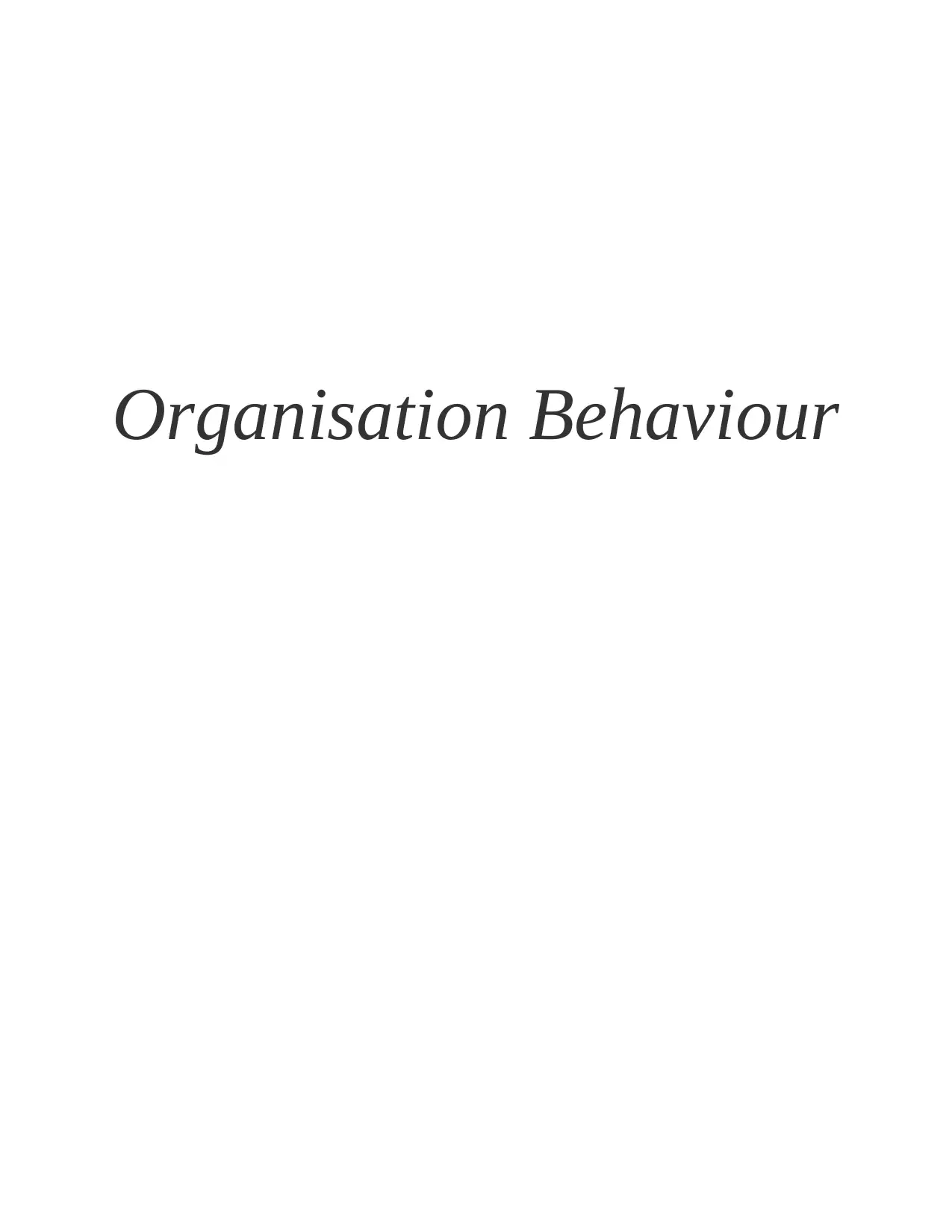
Organisation Behaviour
Secure Best Marks with AI Grader
Need help grading? Try our AI Grader for instant feedback on your assignments.
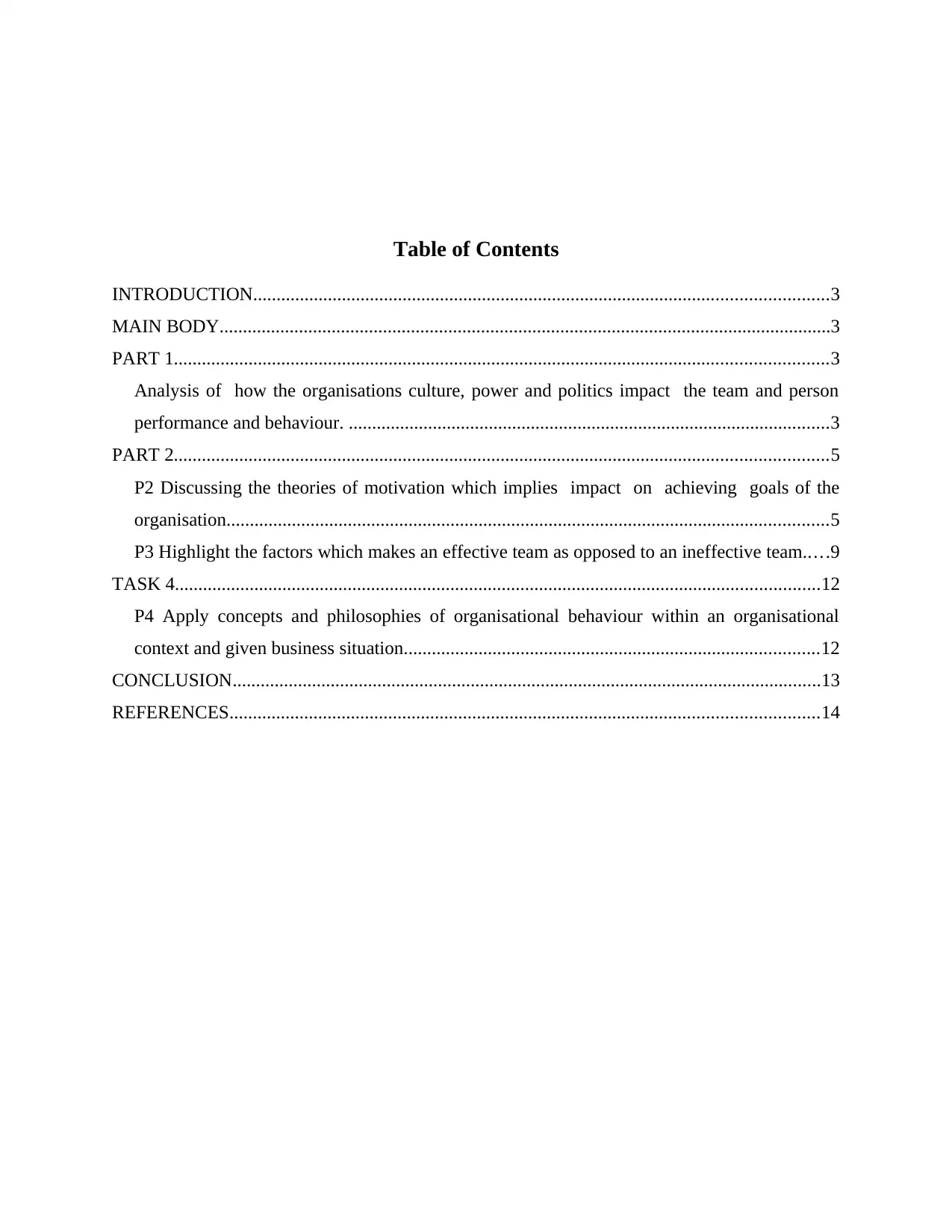
Table of Contents
INTRODUCTION...........................................................................................................................3
MAIN BODY...................................................................................................................................3
PART 1............................................................................................................................................3
Analysis of how the organisations culture, power and politics impact the team and person
performance and behaviour. .......................................................................................................3
PART 2............................................................................................................................................5
P2 Discussing the theories of motivation which implies impact on achieving goals of the
organisation.................................................................................................................................5
P3 Highlight the factors which makes an effective team as opposed to an ineffective team.....9
TASK 4..........................................................................................................................................12
P4 Apply concepts and philosophies of organisational behaviour within an organisational
context and given business situation.........................................................................................12
CONCLUSION..............................................................................................................................13
REFERENCES..............................................................................................................................14
INTRODUCTION...........................................................................................................................3
MAIN BODY...................................................................................................................................3
PART 1............................................................................................................................................3
Analysis of how the organisations culture, power and politics impact the team and person
performance and behaviour. .......................................................................................................3
PART 2............................................................................................................................................5
P2 Discussing the theories of motivation which implies impact on achieving goals of the
organisation.................................................................................................................................5
P3 Highlight the factors which makes an effective team as opposed to an ineffective team.....9
TASK 4..........................................................................................................................................12
P4 Apply concepts and philosophies of organisational behaviour within an organisational
context and given business situation.........................................................................................12
CONCLUSION..............................................................................................................................13
REFERENCES..............................................................................................................................14
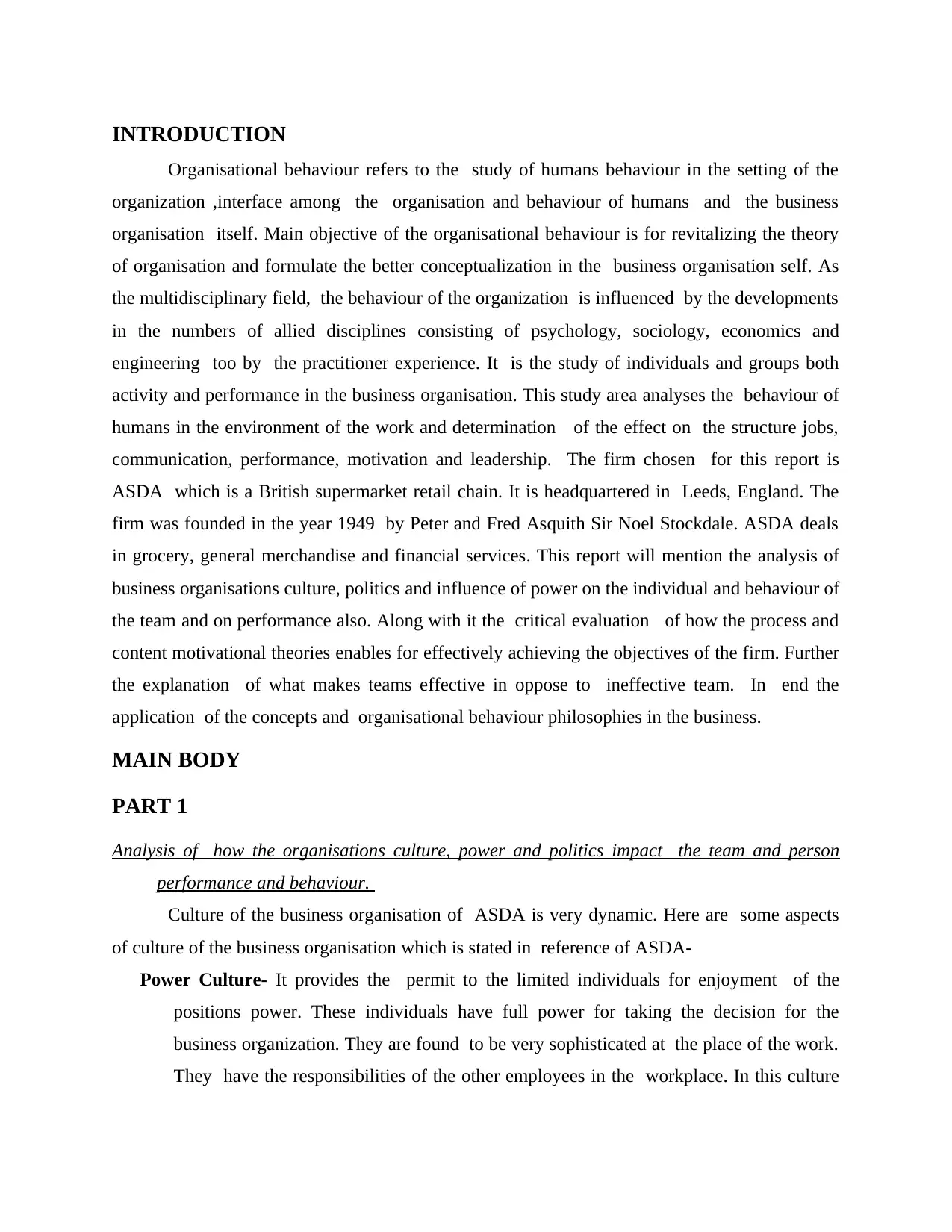
INTRODUCTION
Organisational behaviour refers to the study of humans behaviour in the setting of the
organization ,interface among the organisation and behaviour of humans and the business
organisation itself. Main objective of the organisational behaviour is for revitalizing the theory
of organisation and formulate the better conceptualization in the business organisation self. As
the multidisciplinary field, the behaviour of the organization is influenced by the developments
in the numbers of allied disciplines consisting of psychology, sociology, economics and
engineering too by the practitioner experience. It is the study of individuals and groups both
activity and performance in the business organisation. This study area analyses the behaviour of
humans in the environment of the work and determination of the effect on the structure jobs,
communication, performance, motivation and leadership. The firm chosen for this report is
ASDA which is a British supermarket retail chain. It is headquartered in Leeds, England. The
firm was founded in the year 1949 by Peter and Fred Asquith Sir Noel Stockdale. ASDA deals
in grocery, general merchandise and financial services. This report will mention the analysis of
business organisations culture, politics and influence of power on the individual and behaviour of
the team and on performance also. Along with it the critical evaluation of how the process and
content motivational theories enables for effectively achieving the objectives of the firm. Further
the explanation of what makes teams effective in oppose to ineffective team. In end the
application of the concepts and organisational behaviour philosophies in the business.
MAIN BODY
PART 1
Analysis of how the organisations culture, power and politics impact the team and person
performance and behaviour.
Culture of the business organisation of ASDA is very dynamic. Here are some aspects
of culture of the business organisation which is stated in reference of ASDA-
Power Culture- It provides the permit to the limited individuals for enjoyment of the
positions power. These individuals have full power for taking the decision for the
business organization. They are found to be very sophisticated at the place of the work.
They have the responsibilities of the other employees in the workplace. In this culture
Organisational behaviour refers to the study of humans behaviour in the setting of the
organization ,interface among the organisation and behaviour of humans and the business
organisation itself. Main objective of the organisational behaviour is for revitalizing the theory
of organisation and formulate the better conceptualization in the business organisation self. As
the multidisciplinary field, the behaviour of the organization is influenced by the developments
in the numbers of allied disciplines consisting of psychology, sociology, economics and
engineering too by the practitioner experience. It is the study of individuals and groups both
activity and performance in the business organisation. This study area analyses the behaviour of
humans in the environment of the work and determination of the effect on the structure jobs,
communication, performance, motivation and leadership. The firm chosen for this report is
ASDA which is a British supermarket retail chain. It is headquartered in Leeds, England. The
firm was founded in the year 1949 by Peter and Fred Asquith Sir Noel Stockdale. ASDA deals
in grocery, general merchandise and financial services. This report will mention the analysis of
business organisations culture, politics and influence of power on the individual and behaviour of
the team and on performance also. Along with it the critical evaluation of how the process and
content motivational theories enables for effectively achieving the objectives of the firm. Further
the explanation of what makes teams effective in oppose to ineffective team. In end the
application of the concepts and organisational behaviour philosophies in the business.
MAIN BODY
PART 1
Analysis of how the organisations culture, power and politics impact the team and person
performance and behaviour.
Culture of the business organisation of ASDA is very dynamic. Here are some aspects
of culture of the business organisation which is stated in reference of ASDA-
Power Culture- It provides the permit to the limited individuals for enjoyment of the
positions power. These individuals have full power for taking the decision for the
business organization. They are found to be very sophisticated at the place of the work.
They have the responsibilities of the other employees in the workplace. In this culture
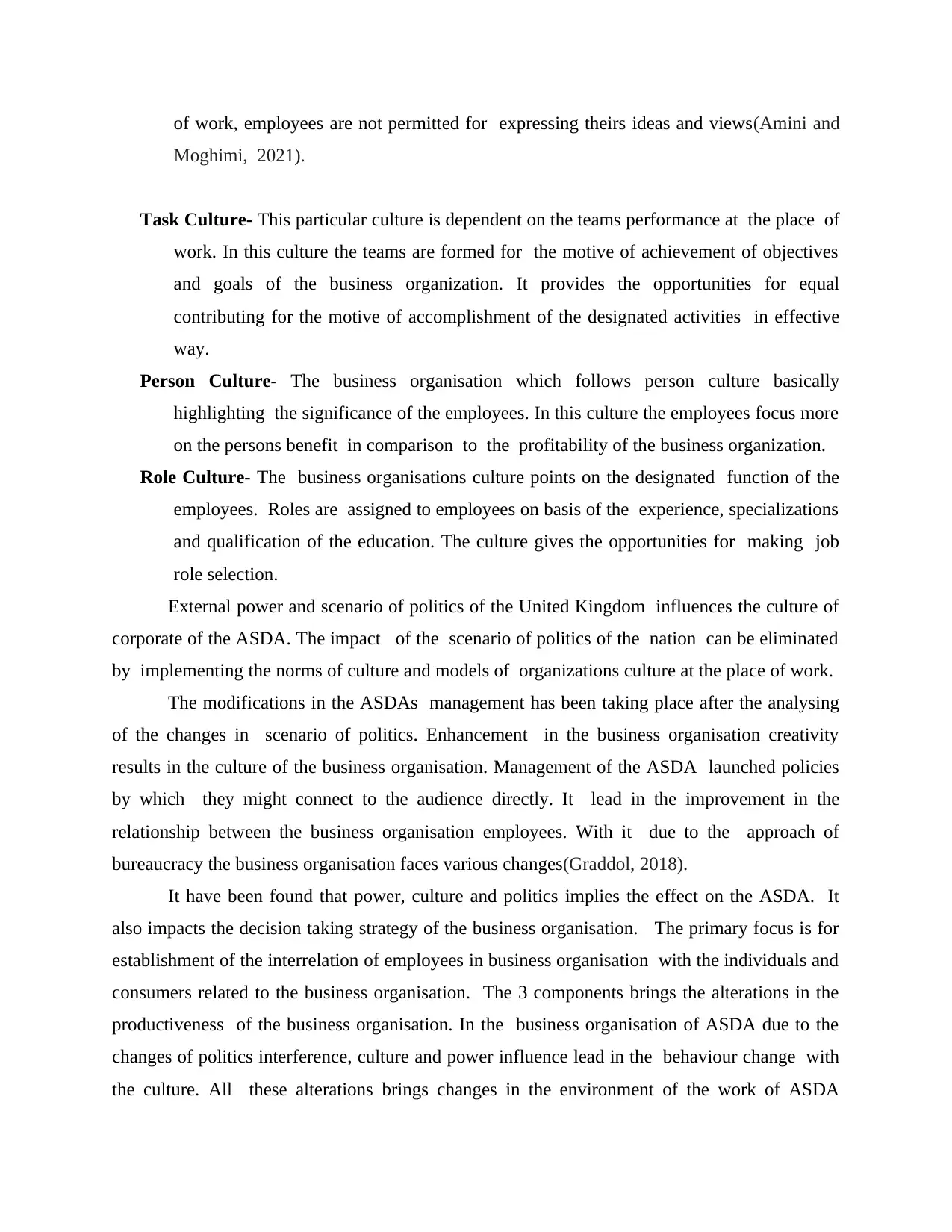
of work, employees are not permitted for expressing theirs ideas and views(Amini and
Moghimi, 2021).
Task Culture- This particular culture is dependent on the teams performance at the place of
work. In this culture the teams are formed for the motive of achievement of objectives
and goals of the business organization. It provides the opportunities for equal
contributing for the motive of accomplishment of the designated activities in effective
way.
Person Culture- The business organisation which follows person culture basically
highlighting the significance of the employees. In this culture the employees focus more
on the persons benefit in comparison to the profitability of the business organization.
Role Culture- The business organisations culture points on the designated function of the
employees. Roles are assigned to employees on basis of the experience, specializations
and qualification of the education. The culture gives the opportunities for making job
role selection.
External power and scenario of politics of the United Kingdom influences the culture of
corporate of the ASDA. The impact of the scenario of politics of the nation can be eliminated
by implementing the norms of culture and models of organizations culture at the place of work.
The modifications in the ASDAs management has been taking place after the analysing
of the changes in scenario of politics. Enhancement in the business organisation creativity
results in the culture of the business organisation. Management of the ASDA launched policies
by which they might connect to the audience directly. It lead in the improvement in the
relationship between the business organisation employees. With it due to the approach of
bureaucracy the business organisation faces various changes(Graddol, 2018).
It have been found that power, culture and politics implies the effect on the ASDA. It
also impacts the decision taking strategy of the business organisation. The primary focus is for
establishment of the interrelation of employees in business organisation with the individuals and
consumers related to the business organisation. The 3 components brings the alterations in the
productiveness of the business organisation. In the business organisation of ASDA due to the
changes of politics interference, culture and power influence lead in the behaviour change with
the culture. All these alterations brings changes in the environment of the work of ASDA
Moghimi, 2021).
Task Culture- This particular culture is dependent on the teams performance at the place of
work. In this culture the teams are formed for the motive of achievement of objectives
and goals of the business organization. It provides the opportunities for equal
contributing for the motive of accomplishment of the designated activities in effective
way.
Person Culture- The business organisation which follows person culture basically
highlighting the significance of the employees. In this culture the employees focus more
on the persons benefit in comparison to the profitability of the business organization.
Role Culture- The business organisations culture points on the designated function of the
employees. Roles are assigned to employees on basis of the experience, specializations
and qualification of the education. The culture gives the opportunities for making job
role selection.
External power and scenario of politics of the United Kingdom influences the culture of
corporate of the ASDA. The impact of the scenario of politics of the nation can be eliminated
by implementing the norms of culture and models of organizations culture at the place of work.
The modifications in the ASDAs management has been taking place after the analysing
of the changes in scenario of politics. Enhancement in the business organisation creativity
results in the culture of the business organisation. Management of the ASDA launched policies
by which they might connect to the audience directly. It lead in the improvement in the
relationship between the business organisation employees. With it due to the approach of
bureaucracy the business organisation faces various changes(Graddol, 2018).
It have been found that power, culture and politics implies the effect on the ASDA. It
also impacts the decision taking strategy of the business organisation. The primary focus is for
establishment of the interrelation of employees in business organisation with the individuals and
consumers related to the business organisation. The 3 components brings the alterations in the
productiveness of the business organisation. In the business organisation of ASDA due to the
changes of politics interference, culture and power influence lead in the behaviour change with
the culture. All these alterations brings changes in the environment of the work of ASDA
Secure Best Marks with AI Grader
Need help grading? Try our AI Grader for instant feedback on your assignments.
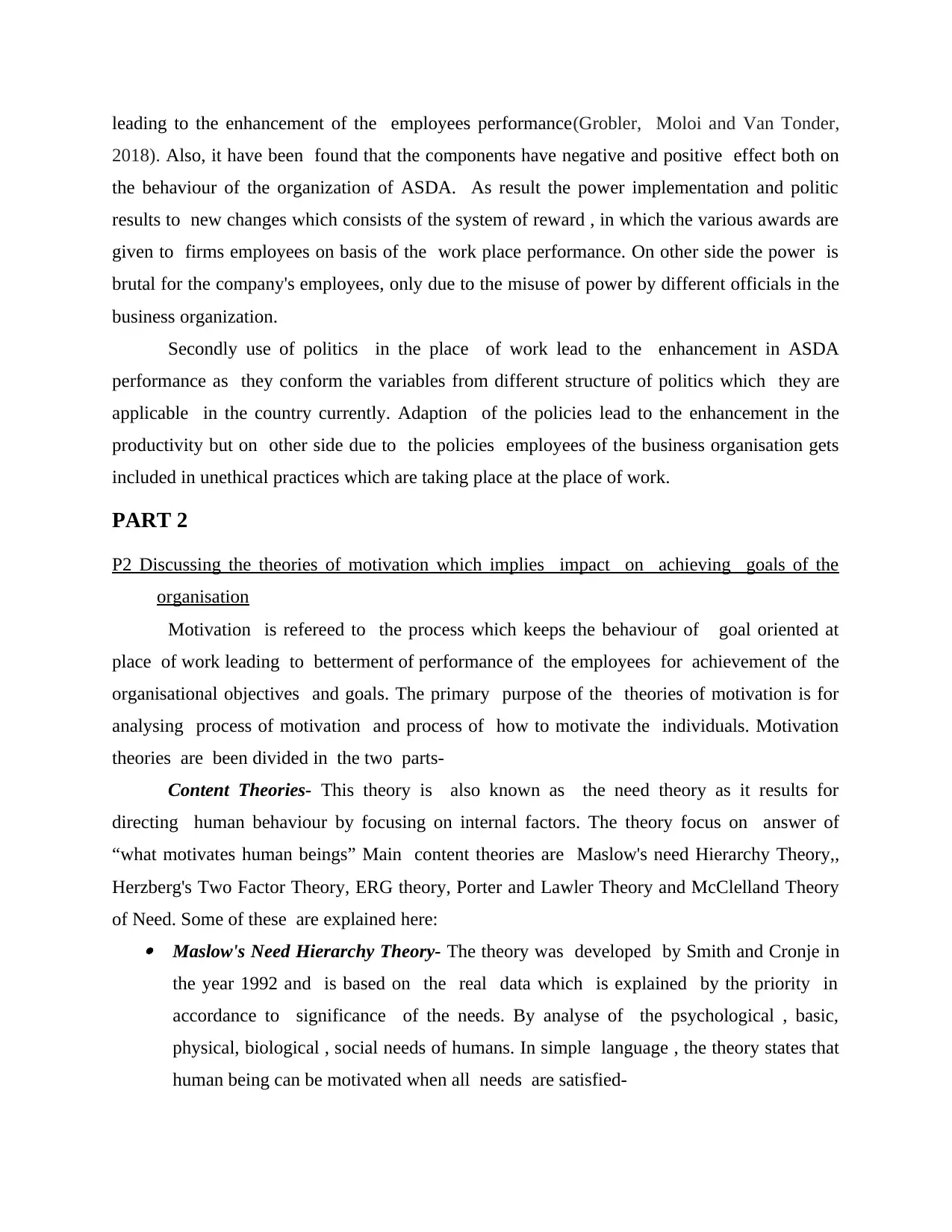
leading to the enhancement of the employees performance(Grobler, Moloi and Van Tonder,
2018). Also, it have been found that the components have negative and positive effect both on
the behaviour of the organization of ASDA. As result the power implementation and politic
results to new changes which consists of the system of reward , in which the various awards are
given to firms employees on basis of the work place performance. On other side the power is
brutal for the company's employees, only due to the misuse of power by different officials in the
business organization.
Secondly use of politics in the place of work lead to the enhancement in ASDA
performance as they conform the variables from different structure of politics which they are
applicable in the country currently. Adaption of the policies lead to the enhancement in the
productivity but on other side due to the policies employees of the business organisation gets
included in unethical practices which are taking place at the place of work.
PART 2
P2 Discussing the theories of motivation which implies impact on achieving goals of the
organisation
Motivation is refereed to the process which keeps the behaviour of goal oriented at
place of work leading to betterment of performance of the employees for achievement of the
organisational objectives and goals. The primary purpose of the theories of motivation is for
analysing process of motivation and process of how to motivate the individuals. Motivation
theories are been divided in the two parts-
Content Theories- This theory is also known as the need theory as it results for
directing human behaviour by focusing on internal factors. The theory focus on answer of
“what motivates human beings” Main content theories are Maslow's need Hierarchy Theory,,
Herzberg's Two Factor Theory, ERG theory, Porter and Lawler Theory and McClelland Theory
of Need. Some of these are explained here: Maslow's Need Hierarchy Theory- The theory was developed by Smith and Cronje in
the year 1992 and is based on the real data which is explained by the priority in
accordance to significance of the needs. By analyse of the psychological , basic,
physical, biological , social needs of humans. In simple language , the theory states that
human being can be motivated when all needs are satisfied-
2018). Also, it have been found that the components have negative and positive effect both on
the behaviour of the organization of ASDA. As result the power implementation and politic
results to new changes which consists of the system of reward , in which the various awards are
given to firms employees on basis of the work place performance. On other side the power is
brutal for the company's employees, only due to the misuse of power by different officials in the
business organization.
Secondly use of politics in the place of work lead to the enhancement in ASDA
performance as they conform the variables from different structure of politics which they are
applicable in the country currently. Adaption of the policies lead to the enhancement in the
productivity but on other side due to the policies employees of the business organisation gets
included in unethical practices which are taking place at the place of work.
PART 2
P2 Discussing the theories of motivation which implies impact on achieving goals of the
organisation
Motivation is refereed to the process which keeps the behaviour of goal oriented at
place of work leading to betterment of performance of the employees for achievement of the
organisational objectives and goals. The primary purpose of the theories of motivation is for
analysing process of motivation and process of how to motivate the individuals. Motivation
theories are been divided in the two parts-
Content Theories- This theory is also known as the need theory as it results for
directing human behaviour by focusing on internal factors. The theory focus on answer of
“what motivates human beings” Main content theories are Maslow's need Hierarchy Theory,,
Herzberg's Two Factor Theory, ERG theory, Porter and Lawler Theory and McClelland Theory
of Need. Some of these are explained here: Maslow's Need Hierarchy Theory- The theory was developed by Smith and Cronje in
the year 1992 and is based on the real data which is explained by the priority in
accordance to significance of the needs. By analyse of the psychological , basic,
physical, biological , social needs of humans. In simple language , the theory states that
human being can be motivated when all needs are satisfied-
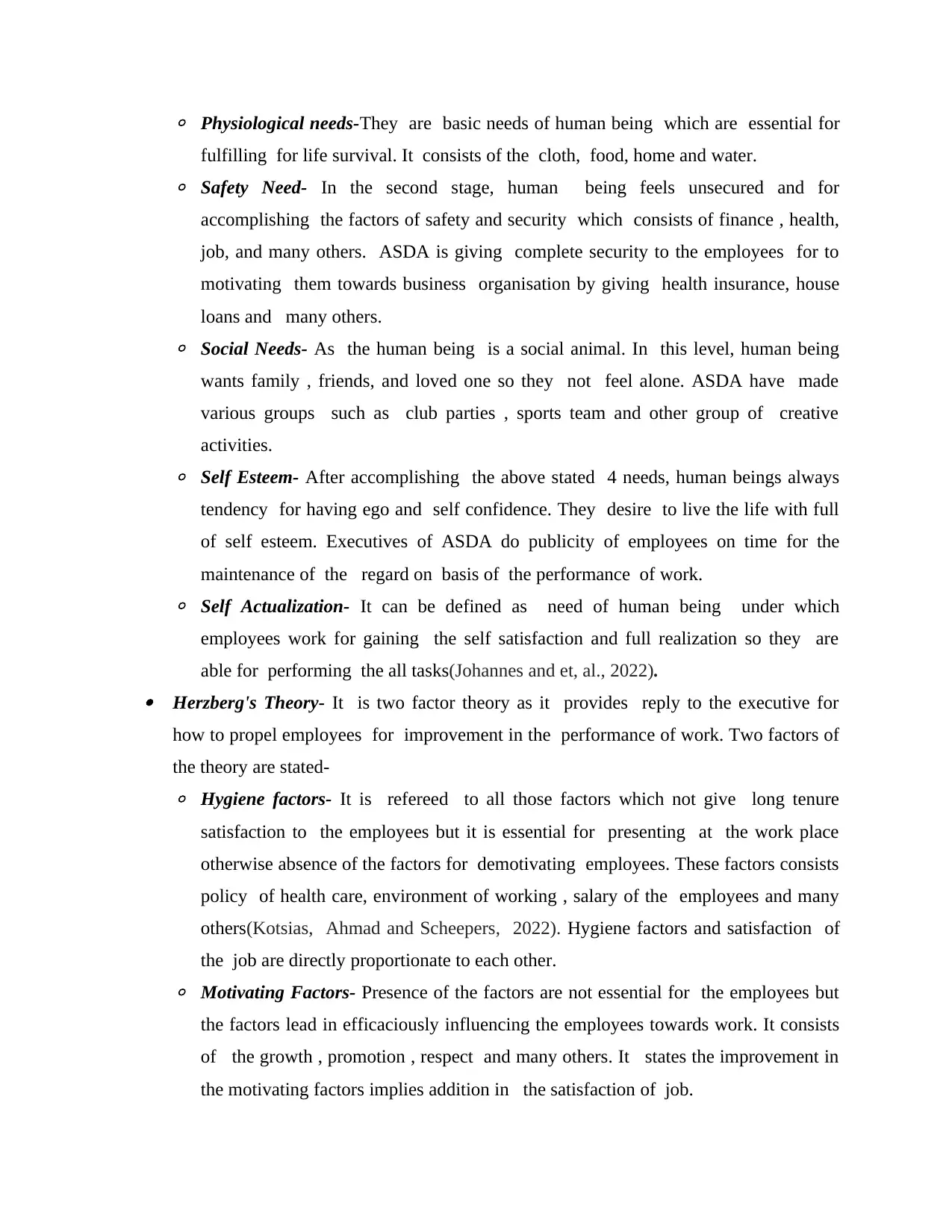
◦ Physiological needs-They are basic needs of human being which are essential for
fulfilling for life survival. It consists of the cloth, food, home and water.
◦ Safety Need- In the second stage, human being feels unsecured and for
accomplishing the factors of safety and security which consists of finance , health,
job, and many others. ASDA is giving complete security to the employees for to
motivating them towards business organisation by giving health insurance, house
loans and many others.
◦ Social Needs- As the human being is a social animal. In this level, human being
wants family , friends, and loved one so they not feel alone. ASDA have made
various groups such as club parties , sports team and other group of creative
activities.
◦ Self Esteem- After accomplishing the above stated 4 needs, human beings always
tendency for having ego and self confidence. They desire to live the life with full
of self esteem. Executives of ASDA do publicity of employees on time for the
maintenance of the regard on basis of the performance of work.
◦ Self Actualization- It can be defined as need of human being under which
employees work for gaining the self satisfaction and full realization so they are
able for performing the all tasks(Johannes and et, al., 2022). Herzberg's Theory- It is two factor theory as it provides reply to the executive for
how to propel employees for improvement in the performance of work. Two factors of
the theory are stated-
◦ Hygiene factors- It is refereed to all those factors which not give long tenure
satisfaction to the employees but it is essential for presenting at the work place
otherwise absence of the factors for demotivating employees. These factors consists
policy of health care, environment of working , salary of the employees and many
others(Kotsias, Ahmad and Scheepers, 2022). Hygiene factors and satisfaction of
the job are directly proportionate to each other.
◦ Motivating Factors- Presence of the factors are not essential for the employees but
the factors lead in efficaciously influencing the employees towards work. It consists
of the growth , promotion , respect and many others. It states the improvement in
the motivating factors implies addition in the satisfaction of job.
fulfilling for life survival. It consists of the cloth, food, home and water.
◦ Safety Need- In the second stage, human being feels unsecured and for
accomplishing the factors of safety and security which consists of finance , health,
job, and many others. ASDA is giving complete security to the employees for to
motivating them towards business organisation by giving health insurance, house
loans and many others.
◦ Social Needs- As the human being is a social animal. In this level, human being
wants family , friends, and loved one so they not feel alone. ASDA have made
various groups such as club parties , sports team and other group of creative
activities.
◦ Self Esteem- After accomplishing the above stated 4 needs, human beings always
tendency for having ego and self confidence. They desire to live the life with full
of self esteem. Executives of ASDA do publicity of employees on time for the
maintenance of the regard on basis of the performance of work.
◦ Self Actualization- It can be defined as need of human being under which
employees work for gaining the self satisfaction and full realization so they are
able for performing the all tasks(Johannes and et, al., 2022). Herzberg's Theory- It is two factor theory as it provides reply to the executive for
how to propel employees for improvement in the performance of work. Two factors of
the theory are stated-
◦ Hygiene factors- It is refereed to all those factors which not give long tenure
satisfaction to the employees but it is essential for presenting at the work place
otherwise absence of the factors for demotivating employees. These factors consists
policy of health care, environment of working , salary of the employees and many
others(Kotsias, Ahmad and Scheepers, 2022). Hygiene factors and satisfaction of
the job are directly proportionate to each other.
◦ Motivating Factors- Presence of the factors are not essential for the employees but
the factors lead in efficaciously influencing the employees towards work. It consists
of the growth , promotion , respect and many others. It states the improvement in
the motivating factors implies addition in the satisfaction of job.
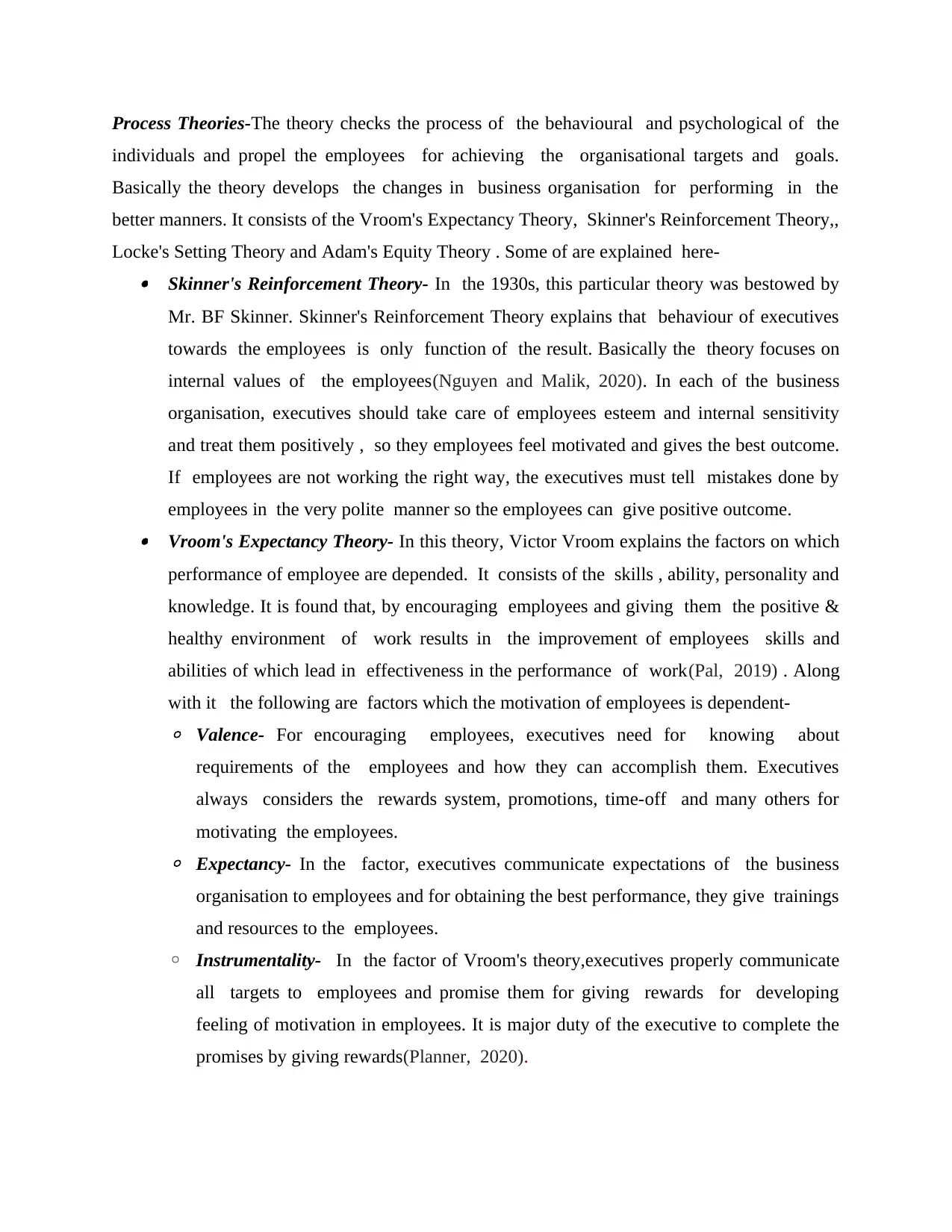
Process Theories-The theory checks the process of the behavioural and psychological of the
individuals and propel the employees for achieving the organisational targets and goals.
Basically the theory develops the changes in business organisation for performing in the
better manners. It consists of the Vroom's Expectancy Theory, Skinner's Reinforcement Theory,,
Locke's Setting Theory and Adam's Equity Theory . Some of are explained here- Skinner's Reinforcement Theory- In the 1930s, this particular theory was bestowed by
Mr. BF Skinner. Skinner's Reinforcement Theory explains that behaviour of executives
towards the employees is only function of the result. Basically the theory focuses on
internal values of the employees(Nguyen and Malik, 2020). In each of the business
organisation, executives should take care of employees esteem and internal sensitivity
and treat them positively , so they employees feel motivated and gives the best outcome.
If employees are not working the right way, the executives must tell mistakes done by
employees in the very polite manner so the employees can give positive outcome. Vroom's Expectancy Theory- In this theory, Victor Vroom explains the factors on which
performance of employee are depended. It consists of the skills , ability, personality and
knowledge. It is found that, by encouraging employees and giving them the positive &
healthy environment of work results in the improvement of employees skills and
abilities of which lead in effectiveness in the performance of work(Pal, 2019) . Along
with it the following are factors which the motivation of employees is dependent-
◦ Valence- For encouraging employees, executives need for knowing about
requirements of the employees and how they can accomplish them. Executives
always considers the rewards system, promotions, time-off and many others for
motivating the employees.
◦ Expectancy- In the factor, executives communicate expectations of the business
organisation to employees and for obtaining the best performance, they give trainings
and resources to the employees.
◦ Instrumentality- In the factor of Vroom's theory,executives properly communicate
all targets to employees and promise them for giving rewards for developing
feeling of motivation in employees. It is major duty of the executive to complete the
promises by giving rewards(Planner, 2020).
individuals and propel the employees for achieving the organisational targets and goals.
Basically the theory develops the changes in business organisation for performing in the
better manners. It consists of the Vroom's Expectancy Theory, Skinner's Reinforcement Theory,,
Locke's Setting Theory and Adam's Equity Theory . Some of are explained here- Skinner's Reinforcement Theory- In the 1930s, this particular theory was bestowed by
Mr. BF Skinner. Skinner's Reinforcement Theory explains that behaviour of executives
towards the employees is only function of the result. Basically the theory focuses on
internal values of the employees(Nguyen and Malik, 2020). In each of the business
organisation, executives should take care of employees esteem and internal sensitivity
and treat them positively , so they employees feel motivated and gives the best outcome.
If employees are not working the right way, the executives must tell mistakes done by
employees in the very polite manner so the employees can give positive outcome. Vroom's Expectancy Theory- In this theory, Victor Vroom explains the factors on which
performance of employee are depended. It consists of the skills , ability, personality and
knowledge. It is found that, by encouraging employees and giving them the positive &
healthy environment of work results in the improvement of employees skills and
abilities of which lead in effectiveness in the performance of work(Pal, 2019) . Along
with it the following are factors which the motivation of employees is dependent-
◦ Valence- For encouraging employees, executives need for knowing about
requirements of the employees and how they can accomplish them. Executives
always considers the rewards system, promotions, time-off and many others for
motivating the employees.
◦ Expectancy- In the factor, executives communicate expectations of the business
organisation to employees and for obtaining the best performance, they give trainings
and resources to the employees.
◦ Instrumentality- In the factor of Vroom's theory,executives properly communicate
all targets to employees and promise them for giving rewards for developing
feeling of motivation in employees. It is major duty of the executive to complete the
promises by giving rewards(Planner, 2020).
Paraphrase This Document
Need a fresh take? Get an instant paraphrase of this document with our AI Paraphraser
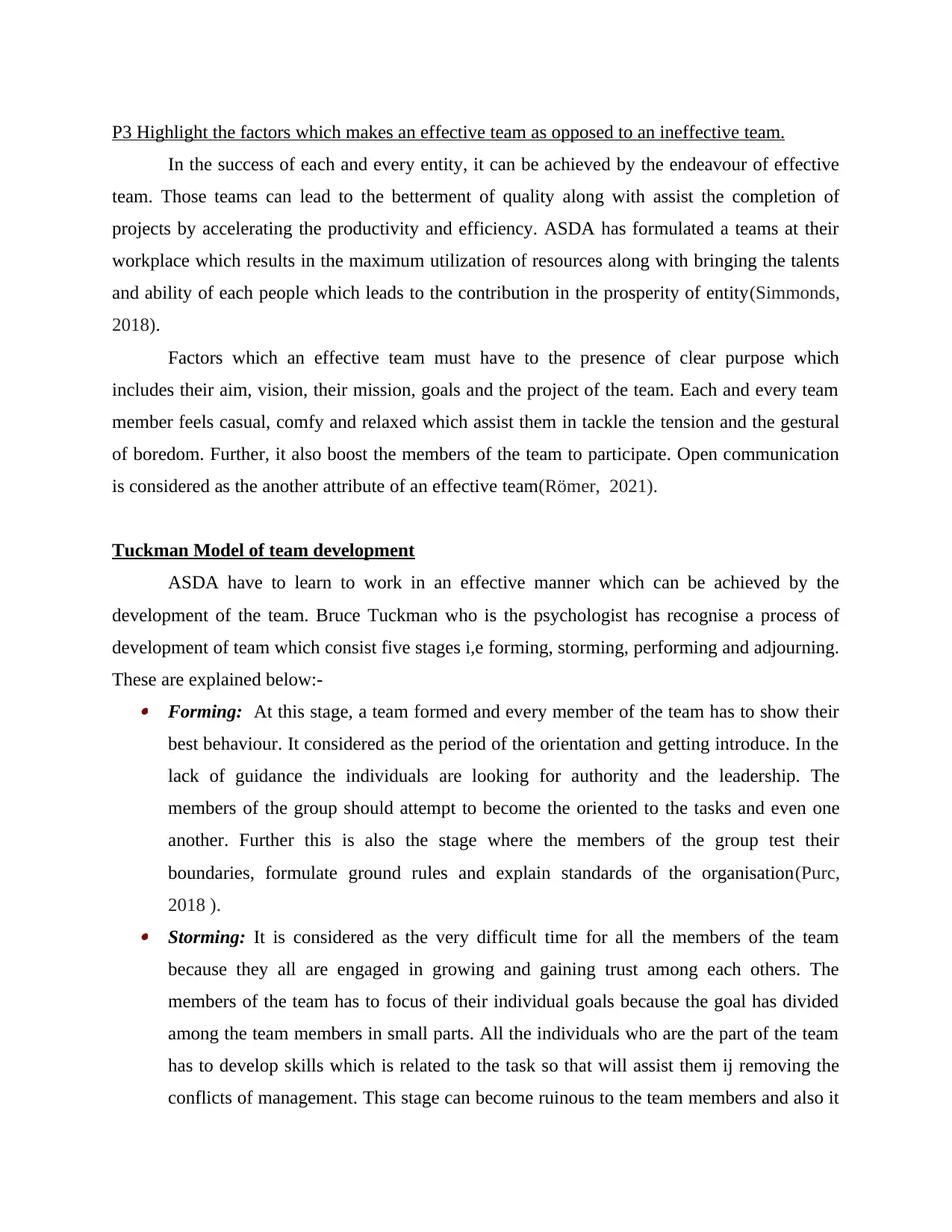
P3 Highlight the factors which makes an effective team as opposed to an ineffective team.
In the success of each and every entity, it can be achieved by the endeavour of effective
team. Those teams can lead to the betterment of quality along with assist the completion of
projects by accelerating the productivity and efficiency. ASDA has formulated a teams at their
workplace which results in the maximum utilization of resources along with bringing the talents
and ability of each people which leads to the contribution in the prosperity of entity(Simmonds,
2018).
Factors which an effective team must have to the presence of clear purpose which
includes their aim, vision, their mission, goals and the project of the team. Each and every team
member feels casual, comfy and relaxed which assist them in tackle the tension and the gestural
of boredom. Further, it also boost the members of the team to participate. Open communication
is considered as the another attribute of an effective team(Römer, 2021).
Tuckman Model of team development
ASDA have to learn to work in an effective manner which can be achieved by the
development of the team. Bruce Tuckman who is the psychologist has recognise a process of
development of team which consist five stages i,e forming, storming, performing and adjourning.
These are explained below:- Forming: At this stage, a team formed and every member of the team has to show their
best behaviour. It considered as the period of the orientation and getting introduce. In the
lack of guidance the individuals are looking for authority and the leadership. The
members of the group should attempt to become the oriented to the tasks and even one
another. Further this is also the stage where the members of the group test their
boundaries, formulate ground rules and explain standards of the organisation(Purc,
2018 ). Storming: It is considered as the very difficult time for all the members of the team
because they all are engaged in growing and gaining trust among each others. The
members of the team has to focus of their individual goals because the goal has divided
among the team members in small parts. All the individuals who are the part of the team
has to develop skills which is related to the task so that will assist them ij removing the
conflicts of management. This stage can become ruinous to the team members and also it
In the success of each and every entity, it can be achieved by the endeavour of effective
team. Those teams can lead to the betterment of quality along with assist the completion of
projects by accelerating the productivity and efficiency. ASDA has formulated a teams at their
workplace which results in the maximum utilization of resources along with bringing the talents
and ability of each people which leads to the contribution in the prosperity of entity(Simmonds,
2018).
Factors which an effective team must have to the presence of clear purpose which
includes their aim, vision, their mission, goals and the project of the team. Each and every team
member feels casual, comfy and relaxed which assist them in tackle the tension and the gestural
of boredom. Further, it also boost the members of the team to participate. Open communication
is considered as the another attribute of an effective team(Römer, 2021).
Tuckman Model of team development
ASDA have to learn to work in an effective manner which can be achieved by the
development of the team. Bruce Tuckman who is the psychologist has recognise a process of
development of team which consist five stages i,e forming, storming, performing and adjourning.
These are explained below:- Forming: At this stage, a team formed and every member of the team has to show their
best behaviour. It considered as the period of the orientation and getting introduce. In the
lack of guidance the individuals are looking for authority and the leadership. The
members of the group should attempt to become the oriented to the tasks and even one
another. Further this is also the stage where the members of the group test their
boundaries, formulate ground rules and explain standards of the organisation(Purc,
2018 ). Storming: It is considered as the very difficult time for all the members of the team
because they all are engaged in growing and gaining trust among each others. The
members of the team has to focus of their individual goals because the goal has divided
among the team members in small parts. All the individuals who are the part of the team
has to develop skills which is related to the task so that will assist them ij removing the
conflicts of management. This stage can become ruinous to the team members and also it
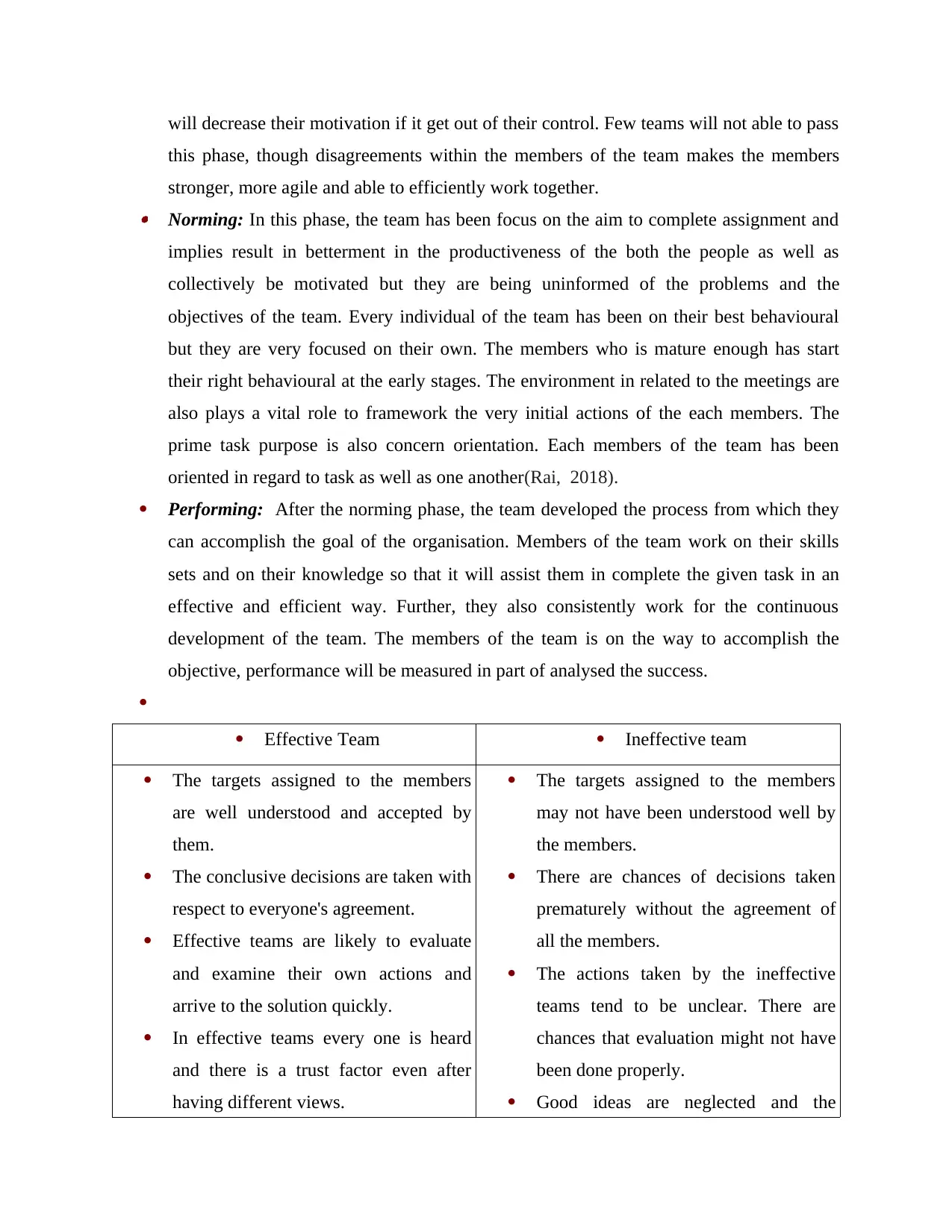
will decrease their motivation if it get out of their control. Few teams will not able to pass
this phase, though disagreements within the members of the team makes the members
stronger, more agile and able to efficiently work together. Norming: In this phase, the team has been focus on the aim to complete assignment and
implies result in betterment in the productiveness of the both the people as well as
collectively be motivated but they are being uninformed of the problems and the
objectives of the team. Every individual of the team has been on their best behavioural
but they are very focused on their own. The members who is mature enough has start
their right behavioural at the early stages. The environment in related to the meetings are
also plays a vital role to framework the very initial actions of the each members. The
prime task purpose is also concern orientation. Each members of the team has been
oriented in regard to task as well as one another(Rai, 2018).
Performing: After the norming phase, the team developed the process from which they
can accomplish the goal of the organisation. Members of the team work on their skills
sets and on their knowledge so that it will assist them in complete the given task in an
effective and efficient way. Further, they also consistently work for the continuous
development of the team. The members of the team is on the way to accomplish the
objective, performance will be measured in part of analysed the success.
Effective Team Ineffective team
The targets assigned to the members
are well understood and accepted by
them.
The conclusive decisions are taken with
respect to everyone's agreement.
Effective teams are likely to evaluate
and examine their own actions and
arrive to the solution quickly.
In effective teams every one is heard
and there is a trust factor even after
having different views.
The targets assigned to the members
may not have been understood well by
the members.
There are chances of decisions taken
prematurely without the agreement of
all the members.
The actions taken by the ineffective
teams tend to be unclear. There are
chances that evaluation might not have
been done properly.
Good ideas are neglected and the
this phase, though disagreements within the members of the team makes the members
stronger, more agile and able to efficiently work together. Norming: In this phase, the team has been focus on the aim to complete assignment and
implies result in betterment in the productiveness of the both the people as well as
collectively be motivated but they are being uninformed of the problems and the
objectives of the team. Every individual of the team has been on their best behavioural
but they are very focused on their own. The members who is mature enough has start
their right behavioural at the early stages. The environment in related to the meetings are
also plays a vital role to framework the very initial actions of the each members. The
prime task purpose is also concern orientation. Each members of the team has been
oriented in regard to task as well as one another(Rai, 2018).
Performing: After the norming phase, the team developed the process from which they
can accomplish the goal of the organisation. Members of the team work on their skills
sets and on their knowledge so that it will assist them in complete the given task in an
effective and efficient way. Further, they also consistently work for the continuous
development of the team. The members of the team is on the way to accomplish the
objective, performance will be measured in part of analysed the success.
Effective Team Ineffective team
The targets assigned to the members
are well understood and accepted by
them.
The conclusive decisions are taken with
respect to everyone's agreement.
Effective teams are likely to evaluate
and examine their own actions and
arrive to the solution quickly.
In effective teams every one is heard
and there is a trust factor even after
having different views.
The targets assigned to the members
may not have been understood well by
the members.
There are chances of decisions taken
prematurely without the agreement of
all the members.
The actions taken by the ineffective
teams tend to be unclear. There are
chances that evaluation might not have
been done properly.
Good ideas are neglected and the
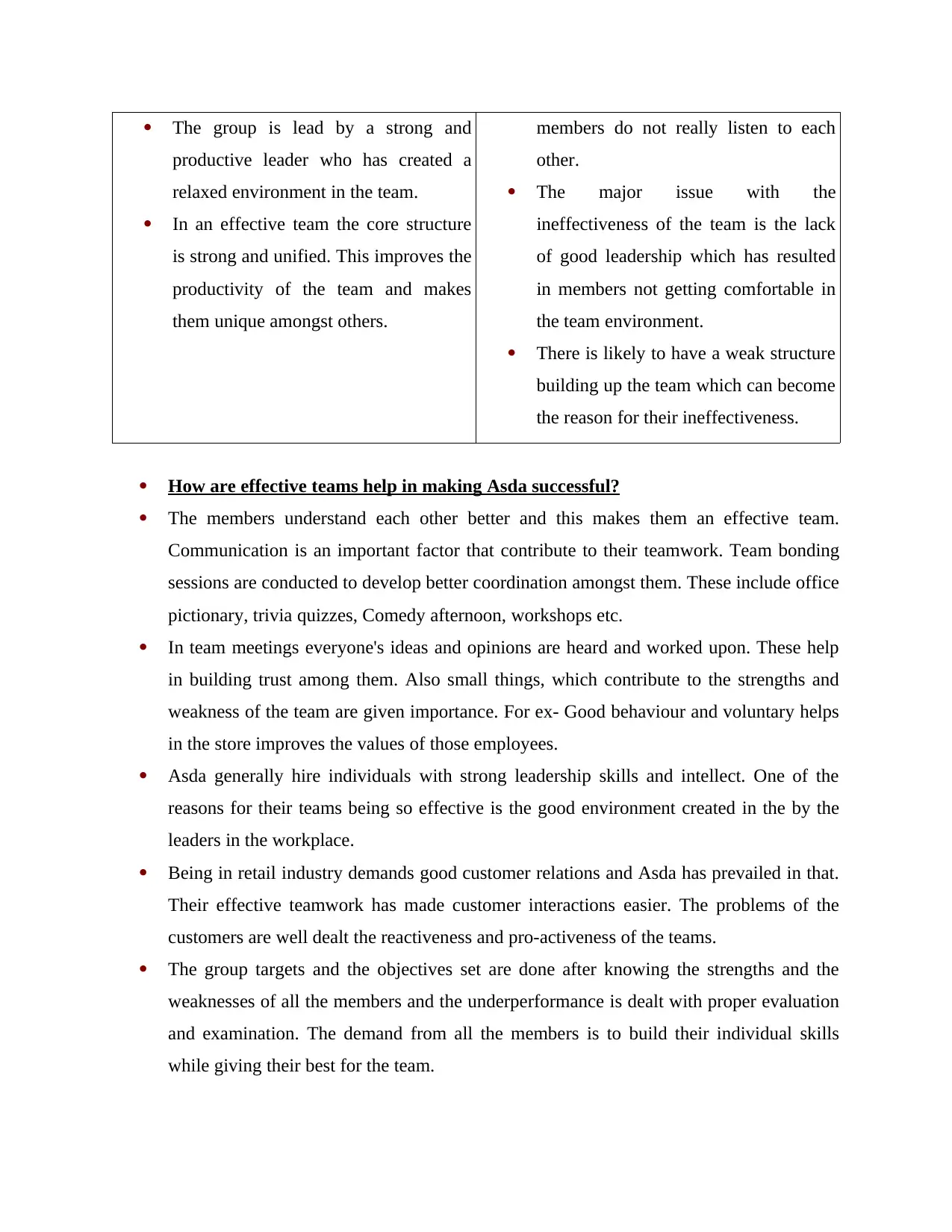
The group is lead by a strong and
productive leader who has created a
relaxed environment in the team.
In an effective team the core structure
is strong and unified. This improves the
productivity of the team and makes
them unique amongst others.
members do not really listen to each
other.
The major issue with the
ineffectiveness of the team is the lack
of good leadership which has resulted
in members not getting comfortable in
the team environment.
There is likely to have a weak structure
building up the team which can become
the reason for their ineffectiveness.
How are effective teams help in making Asda successful?
The members understand each other better and this makes them an effective team.
Communication is an important factor that contribute to their teamwork. Team bonding
sessions are conducted to develop better coordination amongst them. These include office
pictionary, trivia quizzes, Comedy afternoon, workshops etc.
In team meetings everyone's ideas and opinions are heard and worked upon. These help
in building trust among them. Also small things, which contribute to the strengths and
weakness of the team are given importance. For ex- Good behaviour and voluntary helps
in the store improves the values of those employees.
Asda generally hire individuals with strong leadership skills and intellect. One of the
reasons for their teams being so effective is the good environment created in the by the
leaders in the workplace.
Being in retail industry demands good customer relations and Asda has prevailed in that.
Their effective teamwork has made customer interactions easier. The problems of the
customers are well dealt the reactiveness and pro-activeness of the teams.
The group targets and the objectives set are done after knowing the strengths and the
weaknesses of all the members and the underperformance is dealt with proper evaluation
and examination. The demand from all the members is to build their individual skills
while giving their best for the team.
productive leader who has created a
relaxed environment in the team.
In an effective team the core structure
is strong and unified. This improves the
productivity of the team and makes
them unique amongst others.
members do not really listen to each
other.
The major issue with the
ineffectiveness of the team is the lack
of good leadership which has resulted
in members not getting comfortable in
the team environment.
There is likely to have a weak structure
building up the team which can become
the reason for their ineffectiveness.
How are effective teams help in making Asda successful?
The members understand each other better and this makes them an effective team.
Communication is an important factor that contribute to their teamwork. Team bonding
sessions are conducted to develop better coordination amongst them. These include office
pictionary, trivia quizzes, Comedy afternoon, workshops etc.
In team meetings everyone's ideas and opinions are heard and worked upon. These help
in building trust among them. Also small things, which contribute to the strengths and
weakness of the team are given importance. For ex- Good behaviour and voluntary helps
in the store improves the values of those employees.
Asda generally hire individuals with strong leadership skills and intellect. One of the
reasons for their teams being so effective is the good environment created in the by the
leaders in the workplace.
Being in retail industry demands good customer relations and Asda has prevailed in that.
Their effective teamwork has made customer interactions easier. The problems of the
customers are well dealt the reactiveness and pro-activeness of the teams.
The group targets and the objectives set are done after knowing the strengths and the
weaknesses of all the members and the underperformance is dealt with proper evaluation
and examination. The demand from all the members is to build their individual skills
while giving their best for the team.
Secure Best Marks with AI Grader
Need help grading? Try our AI Grader for instant feedback on your assignments.
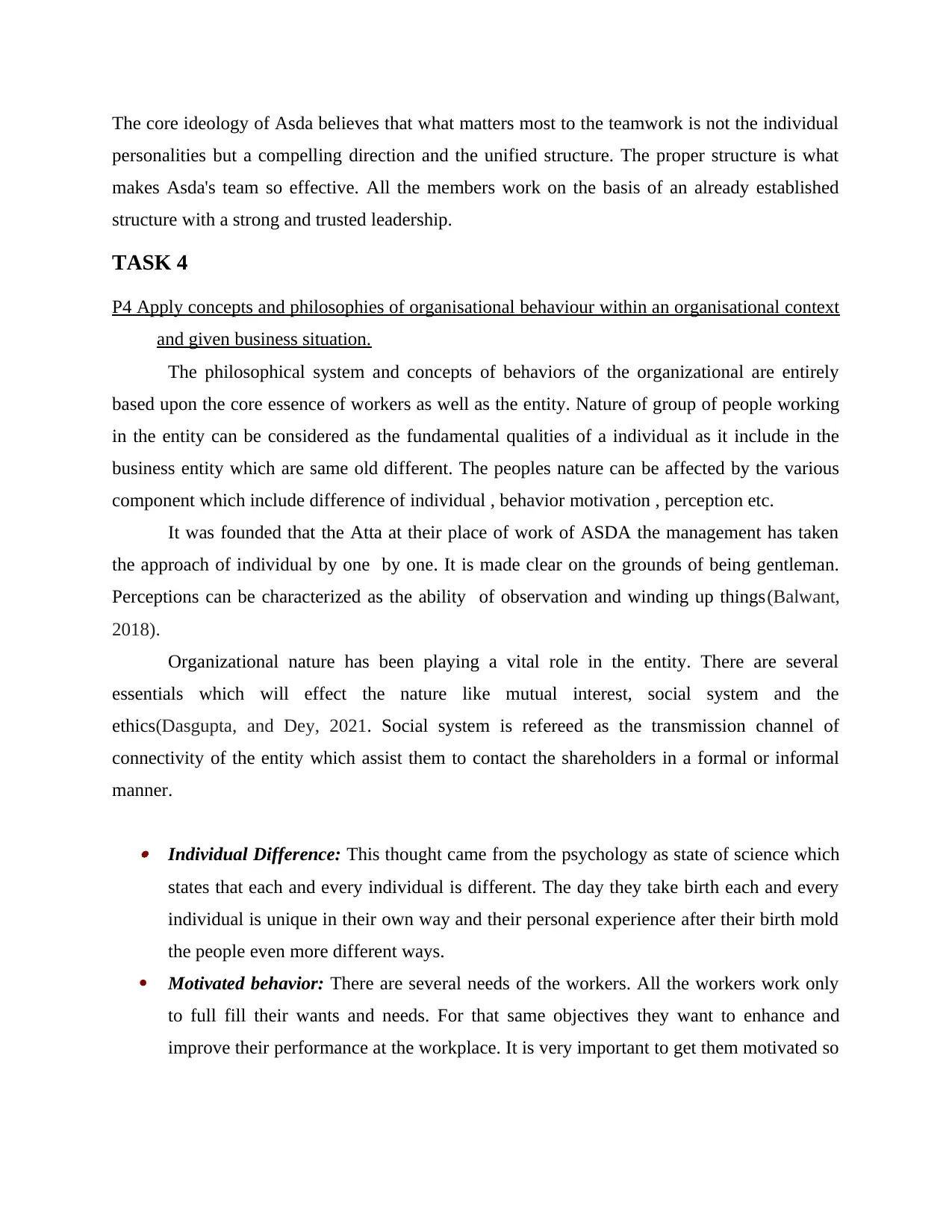
The core ideology of Asda believes that what matters most to the teamwork is not the individual
personalities but a compelling direction and the unified structure. The proper structure is what
makes Asda's team so effective. All the members work on the basis of an already established
structure with a strong and trusted leadership.
TASK 4
P4 Apply concepts and philosophies of organisational behaviour within an organisational context
and given business situation.
The philosophical system and concepts of behaviors of the organizational are entirely
based upon the core essence of workers as well as the entity. Nature of group of people working
in the entity can be considered as the fundamental qualities of a individual as it include in the
business entity which are same old different. The peoples nature can be affected by the various
component which include difference of individual , behavior motivation , perception etc.
It was founded that the Atta at their place of work of ASDA the management has taken
the approach of individual by one by one. It is made clear on the grounds of being gentleman.
Perceptions can be characterized as the ability of observation and winding up things(Balwant,
2018).
Organizational nature has been playing a vital role in the entity. There are several
essentials which will effect the nature like mutual interest, social system and the
ethics(Dasgupta, and Dey, 2021. Social system is refereed as the transmission channel of
connectivity of the entity which assist them to contact the shareholders in a formal or informal
manner.
Individual Difference: This thought came from the psychology as state of science which
states that each and every individual is different. The day they take birth each and every
individual is unique in their own way and their personal experience after their birth mold
the people even more different ways.
Motivated behavior: There are several needs of the workers. All the workers work only
to full fill their wants and needs. For that same objectives they want to enhance and
improve their performance at the workplace. It is very important to get them motivated so
personalities but a compelling direction and the unified structure. The proper structure is what
makes Asda's team so effective. All the members work on the basis of an already established
structure with a strong and trusted leadership.
TASK 4
P4 Apply concepts and philosophies of organisational behaviour within an organisational context
and given business situation.
The philosophical system and concepts of behaviors of the organizational are entirely
based upon the core essence of workers as well as the entity. Nature of group of people working
in the entity can be considered as the fundamental qualities of a individual as it include in the
business entity which are same old different. The peoples nature can be affected by the various
component which include difference of individual , behavior motivation , perception etc.
It was founded that the Atta at their place of work of ASDA the management has taken
the approach of individual by one by one. It is made clear on the grounds of being gentleman.
Perceptions can be characterized as the ability of observation and winding up things(Balwant,
2018).
Organizational nature has been playing a vital role in the entity. There are several
essentials which will effect the nature like mutual interest, social system and the
ethics(Dasgupta, and Dey, 2021. Social system is refereed as the transmission channel of
connectivity of the entity which assist them to contact the shareholders in a formal or informal
manner.
Individual Difference: This thought came from the psychology as state of science which
states that each and every individual is different. The day they take birth each and every
individual is unique in their own way and their personal experience after their birth mold
the people even more different ways.
Motivated behavior: There are several needs of the workers. All the workers work only
to full fill their wants and needs. For that same objectives they want to enhance and
improve their performance at the workplace. It is very important to get them motivated so
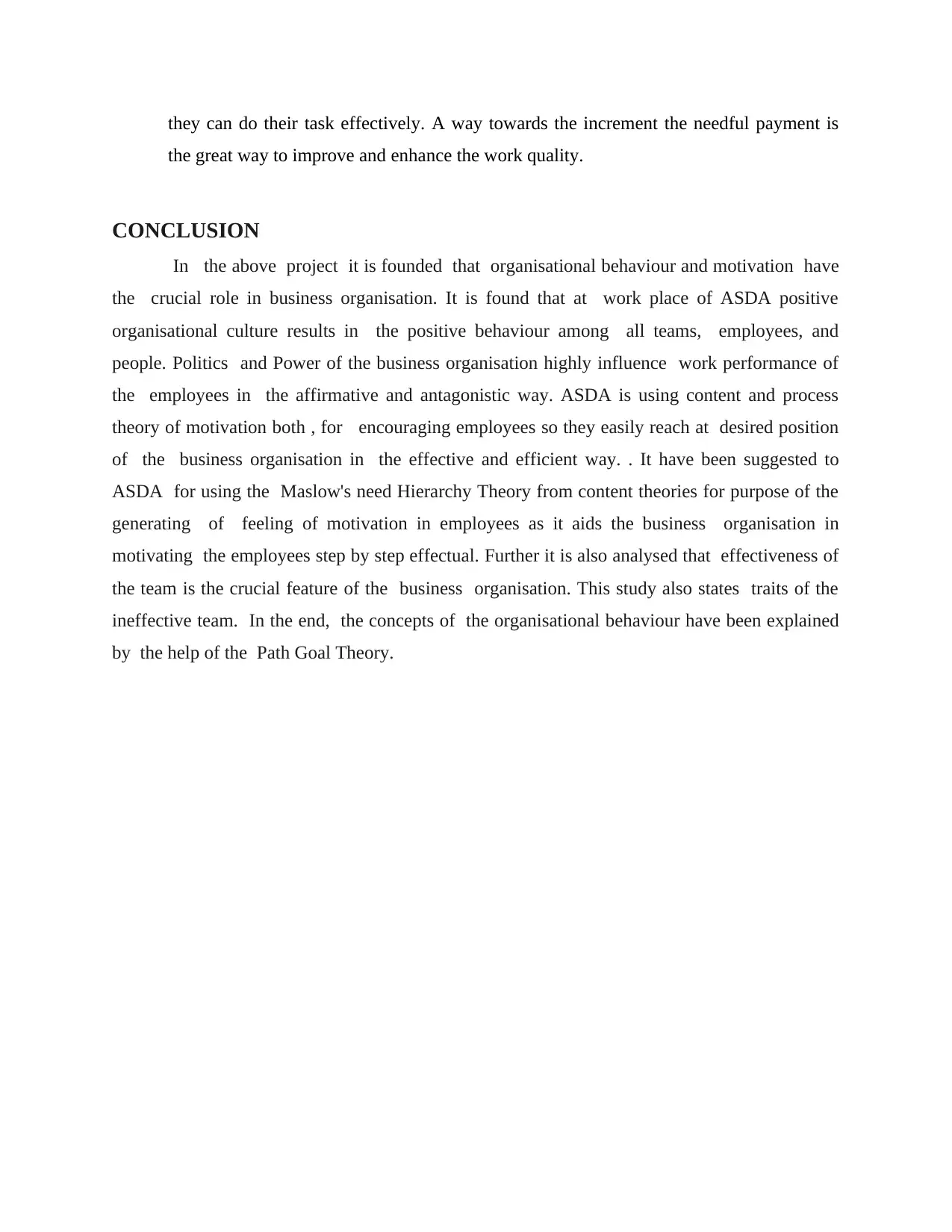
they can do their task effectively. A way towards the increment the needful payment is
the great way to improve and enhance the work quality.
CONCLUSION
In the above project it is founded that organisational behaviour and motivation have
the crucial role in business organisation. It is found that at work place of ASDA positive
organisational culture results in the positive behaviour among all teams, employees, and
people. Politics and Power of the business organisation highly influence work performance of
the employees in the affirmative and antagonistic way. ASDA is using content and process
theory of motivation both , for encouraging employees so they easily reach at desired position
of the business organisation in the effective and efficient way. . It have been suggested to
ASDA for using the Maslow's need Hierarchy Theory from content theories for purpose of the
generating of feeling of motivation in employees as it aids the business organisation in
motivating the employees step by step effectual. Further it is also analysed that effectiveness of
the team is the crucial feature of the business organisation. This study also states traits of the
ineffective team. In the end, the concepts of the organisational behaviour have been explained
by the help of the Path Goal Theory.
the great way to improve and enhance the work quality.
CONCLUSION
In the above project it is founded that organisational behaviour and motivation have
the crucial role in business organisation. It is found that at work place of ASDA positive
organisational culture results in the positive behaviour among all teams, employees, and
people. Politics and Power of the business organisation highly influence work performance of
the employees in the affirmative and antagonistic way. ASDA is using content and process
theory of motivation both , for encouraging employees so they easily reach at desired position
of the business organisation in the effective and efficient way. . It have been suggested to
ASDA for using the Maslow's need Hierarchy Theory from content theories for purpose of the
generating of feeling of motivation in employees as it aids the business organisation in
motivating the employees step by step effectual. Further it is also analysed that effectiveness of
the team is the crucial feature of the business organisation. This study also states traits of the
ineffective team. In the end, the concepts of the organisational behaviour have been explained
by the help of the Path Goal Theory.
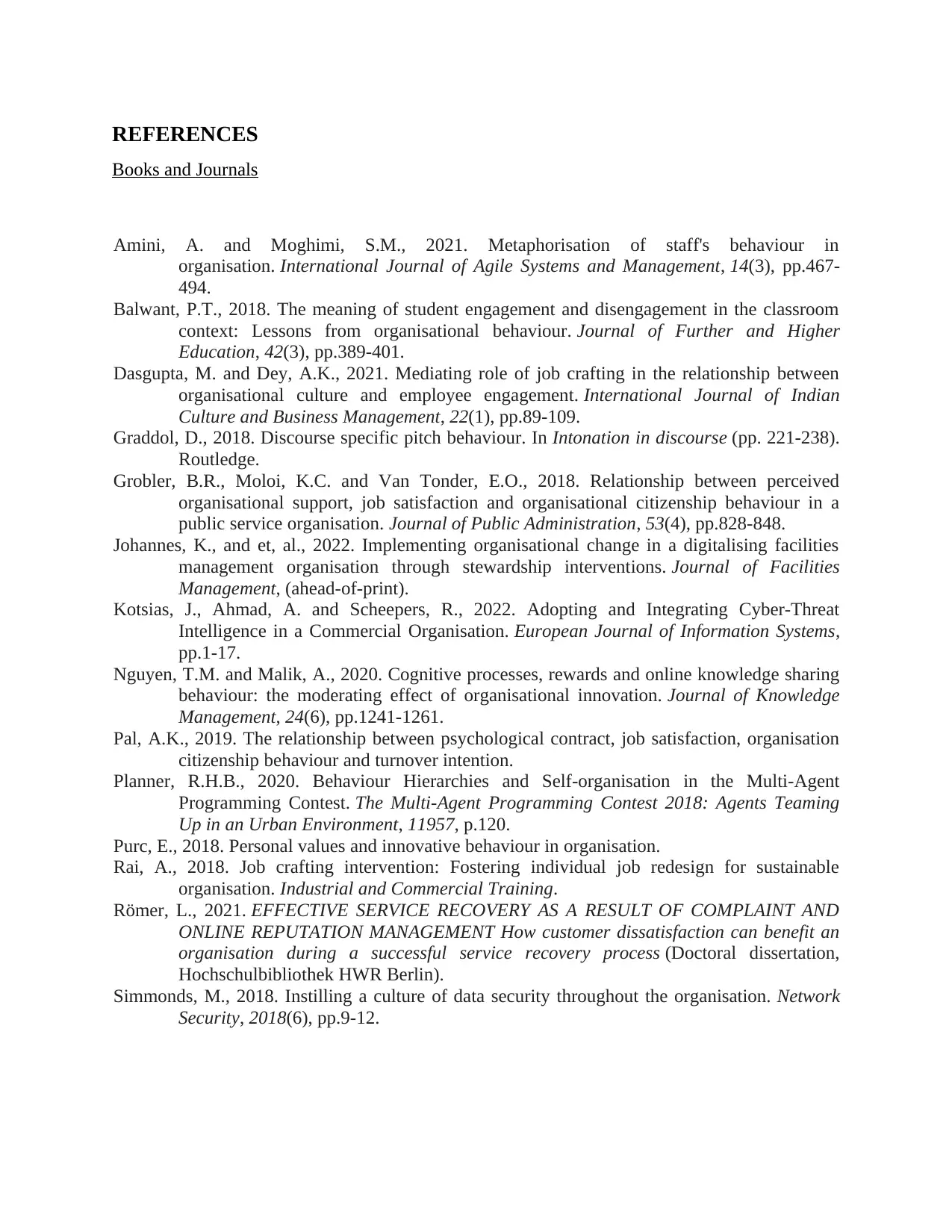
REFERENCES
Books and Journals
Amini, A. and Moghimi, S.M., 2021. Metaphorisation of staff's behaviour in
organisation. International Journal of Agile Systems and Management, 14(3), pp.467-
494.
Balwant, P.T., 2018. The meaning of student engagement and disengagement in the classroom
context: Lessons from organisational behaviour. Journal of Further and Higher
Education, 42(3), pp.389-401.
Dasgupta, M. and Dey, A.K., 2021. Mediating role of job crafting in the relationship between
organisational culture and employee engagement. International Journal of Indian
Culture and Business Management, 22(1), pp.89-109.
Graddol, D., 2018. Discourse specific pitch behaviour. In Intonation in discourse (pp. 221-238).
Routledge.
Grobler, B.R., Moloi, K.C. and Van Tonder, E.O., 2018. Relationship between perceived
organisational support, job satisfaction and organisational citizenship behaviour in a
public service organisation. Journal of Public Administration, 53(4), pp.828-848.
Johannes, K., and et, al., 2022. Implementing organisational change in a digitalising facilities
management organisation through stewardship interventions. Journal of Facilities
Management, (ahead-of-print).
Kotsias, J., Ahmad, A. and Scheepers, R., 2022. Adopting and Integrating Cyber-Threat
Intelligence in a Commercial Organisation. European Journal of Information Systems,
pp.1-17.
Nguyen, T.M. and Malik, A., 2020. Cognitive processes, rewards and online knowledge sharing
behaviour: the moderating effect of organisational innovation. Journal of Knowledge
Management, 24(6), pp.1241-1261.
Pal, A.K., 2019. The relationship between psychological contract, job satisfaction, organisation
citizenship behaviour and turnover intention.
Planner, R.H.B., 2020. Behaviour Hierarchies and Self-organisation in the Multi-Agent
Programming Contest. The Multi-Agent Programming Contest 2018: Agents Teaming
Up in an Urban Environment, 11957, p.120.
Purc, E., 2018. Personal values and innovative behaviour in organisation.
Rai, A., 2018. Job crafting intervention: Fostering individual job redesign for sustainable
organisation. Industrial and Commercial Training.
Römer, L., 2021. EFFECTIVE SERVICE RECOVERY AS A RESULT OF COMPLAINT AND
ONLINE REPUTATION MANAGEMENT How customer dissatisfaction can benefit an
organisation during a successful service recovery process (Doctoral dissertation,
Hochschulbibliothek HWR Berlin).
Simmonds, M., 2018. Instilling a culture of data security throughout the organisation. Network
Security, 2018(6), pp.9-12.
Books and Journals
Amini, A. and Moghimi, S.M., 2021. Metaphorisation of staff's behaviour in
organisation. International Journal of Agile Systems and Management, 14(3), pp.467-
494.
Balwant, P.T., 2018. The meaning of student engagement and disengagement in the classroom
context: Lessons from organisational behaviour. Journal of Further and Higher
Education, 42(3), pp.389-401.
Dasgupta, M. and Dey, A.K., 2021. Mediating role of job crafting in the relationship between
organisational culture and employee engagement. International Journal of Indian
Culture and Business Management, 22(1), pp.89-109.
Graddol, D., 2018. Discourse specific pitch behaviour. In Intonation in discourse (pp. 221-238).
Routledge.
Grobler, B.R., Moloi, K.C. and Van Tonder, E.O., 2018. Relationship between perceived
organisational support, job satisfaction and organisational citizenship behaviour in a
public service organisation. Journal of Public Administration, 53(4), pp.828-848.
Johannes, K., and et, al., 2022. Implementing organisational change in a digitalising facilities
management organisation through stewardship interventions. Journal of Facilities
Management, (ahead-of-print).
Kotsias, J., Ahmad, A. and Scheepers, R., 2022. Adopting and Integrating Cyber-Threat
Intelligence in a Commercial Organisation. European Journal of Information Systems,
pp.1-17.
Nguyen, T.M. and Malik, A., 2020. Cognitive processes, rewards and online knowledge sharing
behaviour: the moderating effect of organisational innovation. Journal of Knowledge
Management, 24(6), pp.1241-1261.
Pal, A.K., 2019. The relationship between psychological contract, job satisfaction, organisation
citizenship behaviour and turnover intention.
Planner, R.H.B., 2020. Behaviour Hierarchies and Self-organisation in the Multi-Agent
Programming Contest. The Multi-Agent Programming Contest 2018: Agents Teaming
Up in an Urban Environment, 11957, p.120.
Purc, E., 2018. Personal values and innovative behaviour in organisation.
Rai, A., 2018. Job crafting intervention: Fostering individual job redesign for sustainable
organisation. Industrial and Commercial Training.
Römer, L., 2021. EFFECTIVE SERVICE RECOVERY AS A RESULT OF COMPLAINT AND
ONLINE REPUTATION MANAGEMENT How customer dissatisfaction can benefit an
organisation during a successful service recovery process (Doctoral dissertation,
Hochschulbibliothek HWR Berlin).
Simmonds, M., 2018. Instilling a culture of data security throughout the organisation. Network
Security, 2018(6), pp.9-12.
1 out of 13
Related Documents
Your All-in-One AI-Powered Toolkit for Academic Success.
+13062052269
info@desklib.com
Available 24*7 on WhatsApp / Email
![[object Object]](/_next/static/media/star-bottom.7253800d.svg)
Unlock your academic potential
© 2024 | Zucol Services PVT LTD | All rights reserved.




